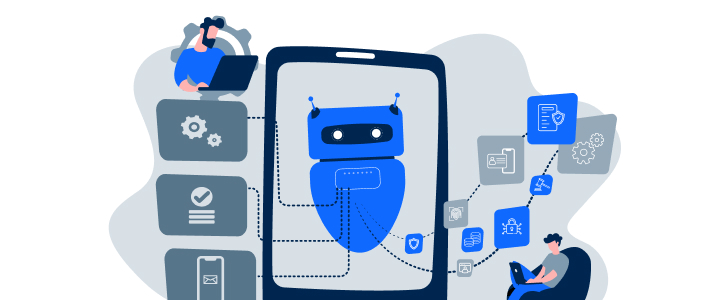Agility within your own four walls
Agile@home // In the past few years, many companies have expressly encouraged and expanded agile working. Constantly advancing digitalization and demand for less employee presence at company offices leads to the question of whether agility can be combined with working from home – and how.
Only a few years ago, working from home was hardly talked about, never mind in demand. After the government’s easing of the re-strictions, both companies and employees remained interested in working from home continuing – at least partially. The widespread introduction of working from home, forced upon the world of work by an external factor, was an abrupt change for many companies and employees, and long-standing approaches had to be quickly adapted to the new situation at short notice. Gradually, companies and their employees got used to the new working reality and the benefits of remote working soon supplanted their initial skepticism.
Agility in the home office and new challenges
As a rule, agile teams develop new solutions via an interdisciplinary, collaborative approach. In the past, this was easiest if all the team members were in direct proximity of one another in the office. Communication pathways were short and direct, meetings could be efficiently conducted, and decision-making was simple.
In this new environment, corporate and personal factors can become an obstacle that has to be overcome. For instance it is important that employees have adequate technical infrastructure available to them. This is the only means of guaranteeing that work can be done at all. Our experience shows that many companies are prepared to provide their employees with the necessary equipment.
Dealing with other influences acting on employees is more difficult, however. When working from home, there is a greater potential for distraction, as many people’s professional and private lives have begun to merge. It is also more difficult to meet and interact with work colleagues, resulting in a loss of social interaction – and a risk of social isolation. Solutions have to be found, established
and developed.
Many of the obstacles posed by working from home for agile organizations could also be regarded as drivers for innovation. This applies to interpersonal processes and support through the appropriate means. A collaborative board serves as the basis for agility and provides an overview of the individual artifacts. In addition, many new providers of interactive tools to promote communication in teams have entered the market in recent years. Rituals, events and meetings – e.g. regular “Virtual Coffees” at ti&m – can also be migrated to the virtual space. For agility, it is indispensable that these interactions continue to take place. Advancing digitalization and increasing demand for these tools play a vital role and make this relationship possible.
Agile working from home in practice
Experience has shown that changing from on-site to remote work can be handled successfully and run smoothly without any major problems. Even in environments with a large number of employees, it has been possible without any difficulties or the emergence of new disturbing factors in the teams. Improvements have even been observed in comparison to on-site working. Many em-ployees were more flexible and more available at the beginning and end of the workday because the at times long commutes were no longer required. Supported by the corresponding tools, the necessary events were moved to the virtual space. In doing so, importance was attached to all meetings and events having a relaxed component that encouraged interaction. This ensured that socializing could take place despite working from home, and that human contact was maintained in the team. With the right tool support, processes and rituals that were purely textual or technical in nature were handled without great difficulty.
However, the transition to a new working reality was not entirely seamless. In particular, it was not always easy to conduct certain events within agile frameworks. Many of the events, tools and methods are still designed for use in physical proximity. The ret-rospectives, Inspect & Adapt and Continuous Improvement were therefore often challenging due to their complexity. Group dynam-ics are harder to foster as there are often not yet opportunities for break-out rooms to accelerate further group formation within the agile teams. And despite the camera function, many meetings are reminiscent of lengthy telephone calls, resulting in a loss of non-verbal communication in many cases. What’s more, integrating new employees in agile teams when working from home takes more time.
Agile working from home: Initial conclusions
In principle, it can be said that agile teamwork also works very well from home. However, agile teams must adapt accordingly, actively create the conditions for remote working, and take into account aspects that promote collaboration in the online world. Important considerations are the necessary hardware and software solutions, clear structures and workflows, set rules and a high degree of communication. Due to the distance between team members, it is important that certain framework conditions are created to ensure agility. Transparent, well-structured information and knowledge management and a properly utilized collaboration platform are elementary and help to further encourage agility. Maintaining all work and events at the same quality in a purely online scenario remains a huge challenge: for more complex projects, additional or new roles may need to be defined in order to meet this. Clear definition of responsibilities and expectations can help to ensure a smoother implementation of such events.
In the future, interpersonal relationships will continue to play a central role in the working world, and these are difficult to foster online. That’s why it is necessary to implement some new rules to ensure a certain structure is maintained. Among other things, this concerns how collaboration tools are used. Measures like the use of cameras and microphones at certain times, fixed core working hours that ensure the full presence of the team, and punctual completion of tasks and obligatory meetings and events can help. If possible, hybrid working should be considered so as to combine the best of both worlds – remote working and on-site collaboration.





